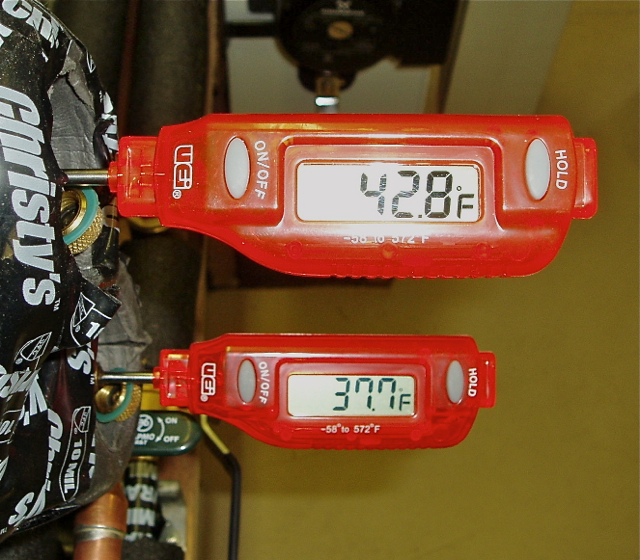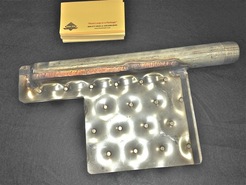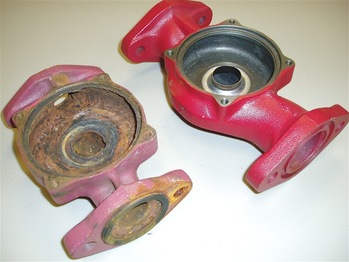Ground Loop Piping and Related Equipment--
With the exception of open loop systems which move water to and from the heat pump by pumping from a lake or standing column well, most ground loops are a closed circulation within high density polyethylene (HDPE pipe). This is usually a moderate wall thickness of SDR-11. That means that the diameter of the opening is 11 times the thickness of the pipe's wall. This ratio would apply proportionately to all HDPE pipe sizes with the SDR-11 label. Our concern in geothermal closed loop applications is that the pipe's wall be thin enough to transfer heat effectively but thick enough to be tough and to avoid crimping, or crushing. Such standards yield a guaranteed service life of 50 years and most everyone discussing this longevity claims 200 years is more like it.
HDPE pipe as ground loops can be buried at any depth (preferably a four foot minimum) in horizontal configuration. This can occur in a number of single or multiple pipe configurations in trenches or wider excavated pits. It can also be looped into a "Slinky"® configuration and placed flat (and sometimes vertically) in a trench. Probably the most common ground loop application with HDPE pipe is when the pipe is sunk as a long, straight loop down a drilled borehole and is backfilled with a grout that hardens and expands after being pumped to fill the borehole from the bottom-up. This grout is a custom mixture of fine, clean sand, bentonite, and water. Both kinds of pipe configurations are featured elsewhere on this Web site as. HORIZONTAL and VERTICAL. The most common diameter sizes for straight pipe runs in horizontal and vertical use are 3/4" and 1".
HDPE pipe as ground loops can be buried at any depth (preferably a four foot minimum) in horizontal configuration. This can occur in a number of single or multiple pipe configurations in trenches or wider excavated pits. It can also be looped into a "Slinky"® configuration and placed flat (and sometimes vertically) in a trench. Probably the most common ground loop application with HDPE pipe is when the pipe is sunk as a long, straight loop down a drilled borehole and is backfilled with a grout that hardens and expands after being pumped to fill the borehole from the bottom-up. This grout is a custom mixture of fine, clean sand, bentonite, and water. Both kinds of pipe configurations are featured elsewhere on this Web site as. HORIZONTAL and VERTICAL. The most common diameter sizes for straight pipe runs in horizontal and vertical use are 3/4" and 1".
The seven loops on the right, at their six foot depth, produced the temperatures seen on the left, halfway through the winter following their burial. The 3/4" inside diameter HDPE pipes circulate an 80% water / 20% methanol solution, referred to as a "brine" in this closed loop configuration. The brine comes from the ground loop and passes through the heat exchanger inside the heat pump before heading back for another trip. Round and round it goes, pumped (in this case) at about 20 gallons per minute.
The digital probe thermometers (above) are inserted into temporary openings in metallic elbows just outside the heat pump. In this diagnostic test, they are registering a 5.1 degree difference between the entering brine and the departing brine. That 20gpm of 5°F brine is used to vaporize the heat pump's internal refrigerant. That refrigerant gas is taken to a compressor (common in all refrigerators, air conditioners, and heat pumps) where it is "superheated," by compression. The rise is sometimes over one hundred degrees! The hot gas is then put to work heating ducted air or piped water. The process is reversed during summer cooling; unwanted heat is sent to the ground loop and absorbed by the surrounding dirt. Greater details of this 7-ton retrofit appear elsewhere on this Web site.
The temperatures displayed in the above photograph are about average for a working ground source heat pump by mid-winter. Although they don't seem high enough to do we humans any good, remember that they are designed to vaporize refrigerant gas. That's the phase change where lots of energy is required (going from liquid-to-vapor) and it's the ground loop that performs this heavy lifting for us. Outside winter air can do it in an air-to-air heat pump, but nowhere near as easily. This is why ground source heat pumps (or geothermal heat pumps, if you prefer) are the most efficient heat transfer technology.
The process of vertical bores requires that a bit be turned and impacted into the earth. The most common boring depth is to provide one ton of heating/cooling capacity per bore, and that's usually 200 feet down, giving us 400 feet of heat exchange pipe when the grouting is complete. Solid rock of various kinds is a stable material for drilling and makes for the best heat conduction through the grout and into the loop (or the reverse). Uniform soils are often easy as well, but any driller will tell you that they can run into almost anything, sometimes requiring the pulling of drill casing and changing of the bit.
Other Ground Loop Equipment--
This is the SlimJim® Lake Plate. On the left, two plates have ballast tubes (above) and supporting pipe "feet" below. The objective is to get these heat exchangers to the bottom of a large pond or lake. That location is the one closest to warmer ground beneath, and the furthest from winter's cold air near the surface. One plate is considered as one ton of capacity, therefore taking the place of 400-to-600 feet of HDPE pipe laid in a trench and buried. Header pipe connections can be seen at the top and bottom of the two plates. The rack is floated and towed into position where the two ballasts are flooded, sinking this rack to the pond/lake bottom.
Fusion (joining) of HDPE pipe--
The HDPE pipe that goes underground must be connected to a closed, circulating loop, no matter what it's deployment: borehole, trench, field, or underwater. This means that the conducting pipe runs need to be connected to header supply and return pipes that convey the brine to the heat pump and back. And that requires pipe joints along the path.
One of the oldest methods of joining two ends of this kind of pipe is butt fusion. The edges of the pipe ends are prepared, heated, and then fused to each other by applying adequate pressure. This is the method going back decades that has been used to connect (yellow) HDPE pipe that carries natural gas (under pressures greater than brine in a ground loop). It is very dependable when done correctly. What follows is a series of images showing the steps in completing but fusion. [A caution—these are practice fusings on short and sometimes smaller sized segments, but the real thing is identical for all sizes in the field.]
One of the oldest methods of joining two ends of this kind of pipe is butt fusion. The edges of the pipe ends are prepared, heated, and then fused to each other by applying adequate pressure. This is the method going back decades that has been used to connect (yellow) HDPE pipe that carries natural gas (under pressures greater than brine in a ground loop). It is very dependable when done correctly. What follows is a series of images showing the steps in completing but fusion. [A caution—these are practice fusings on short and sometimes smaller sized segments, but the real thing is identical for all sizes in the field.]
Photo Gallery of HDPE Butt Fusion
Click on images below for larger views plus caption. Use right arrow to advance to next image in close-up.
Click on images below for larger views plus caption. Use right arrow to advance to next image in close-up.
The above gallery features the butt fusion connection (example) of how header supply and return pipes are joined to take brine from the heat pump to the conducting pipe located in horizontal or deep borehole configuration, where the greatest heat exchange takes place. When such headers connect many loop lines (such as in larger loop fields for commercial or industrial-sized buildings) they come together inside a mechanical room individually (like many spaghetti penetrations through walls) or they are added to larger header pipes so that fewer (or only two) pipes enter the mechanical area, which is preferred. The photos below show a means to gather many header pipes and send in only two to the indoor mechanical area. This is accomplished with the use of an underground (humanly accessible) vault.
Photo Gallery of HDPE Electro-Fusion
Click on images below for larger views plus caption. Use right arrow to advance to next image in close-up.
Click on images below for larger views plus caption. Use right arrow to advance to next image in close-up.
The electro-fusion method (above) is helpful when you are cutting and fitting header piping inside of a building's space with changes in direction and no room for any butt fusion compression apparatus or for socket fusion with its necessary heating iron, separation, and re-connection of heated fittings. With electro-fusion, one can cut, fit, and insert all pipes in place and then return with the electro-fusion machine, which (after reading a fitting's bar code) will automatically apply the correct amount of resistance heat necessary to fuse (melt) the socket and two pipe ends together into a permanent joint.
Header connections for larger loop field systems--
In larger, non-residential buildings there is a need for large loop fields, often combining a number of headers before circulating brine enters a building's mechanical room. Rather than a large number of smaller headers leading to a building, they are often grouped in an underground vault, closer to the loop field. Then, one set of larger header pipes (supply and return) lead to the mechanical room. The use of a vault with individual headers and valves allows the use of a smaller fluid pump to accomplish the flushing and air purging process, because one header set at a time can be flushed and purged with adequate flow velocity. If the system had to be flushed and purged with all headers open and circulating, a pump multiple times larger would be needed for the job.
|
(Right) The importance of purging all air bubbles becomes evident when comparing the rusted vs new pump housings. Air contains oxygen, and even dissolved in liquid, that oxygen can actively form iron oxide (rust). Also, any air pockets trapped in a loop means no ground heat conduction, and that is why we put these systems in the earth. So, purging of air bubbles actually serves more than one purpose. |
|
(Left) The inside of a polyethylene vault; cylindrical in shape and strong enough to resist crushing after burial. It has a watertight hatch and ladder for entry and contains lighting, along with a flat (rustproof) walkway. This is the place where six headers to supply conducting loops have come from larger header pipes tied to the mechanical room. Such vaults can handle not only more supply header sets on the left, but another bank of return headers on the right, (which were not present in this exhibition model). |
|
(Right) Six sub-supply headers are produced from two branches of one larger header. There are valves on each that can modulate flow or stop it completely, plus a drain valve. As can be seen in the above photo, both of these larger pipes are connected to the same run coming from the mechanical room inside a (somewhat) nearby building. |
|
(Left) A view of this vault (exhibition model) with no end piece on the closest opening facing us. The headers run laterally at a depth approximately four feet below the manhole cover at ground level, so they are less likely to be dug up by mechanical equipment. Each of these pipes can be isolated so that it can be flushed and purged individually. This is important because minimum flows are required to accomplish this process, and pumping power adequate to do all six at once is significantly higher. So, with the process on each loop pipe by itself, the circulation pump in the mechanical room (the normal means of moving the ground loop brine in daily operations) can handle the job without importing temporary, larger pumps. With this isolation option (also possible if all these headers went individually to the mechanical room) a suspected underground leak could be located and repaired without digging all of them up. Such a loop could be isolated (while the repair was being accomplished) while the other headers continued in service. |


























